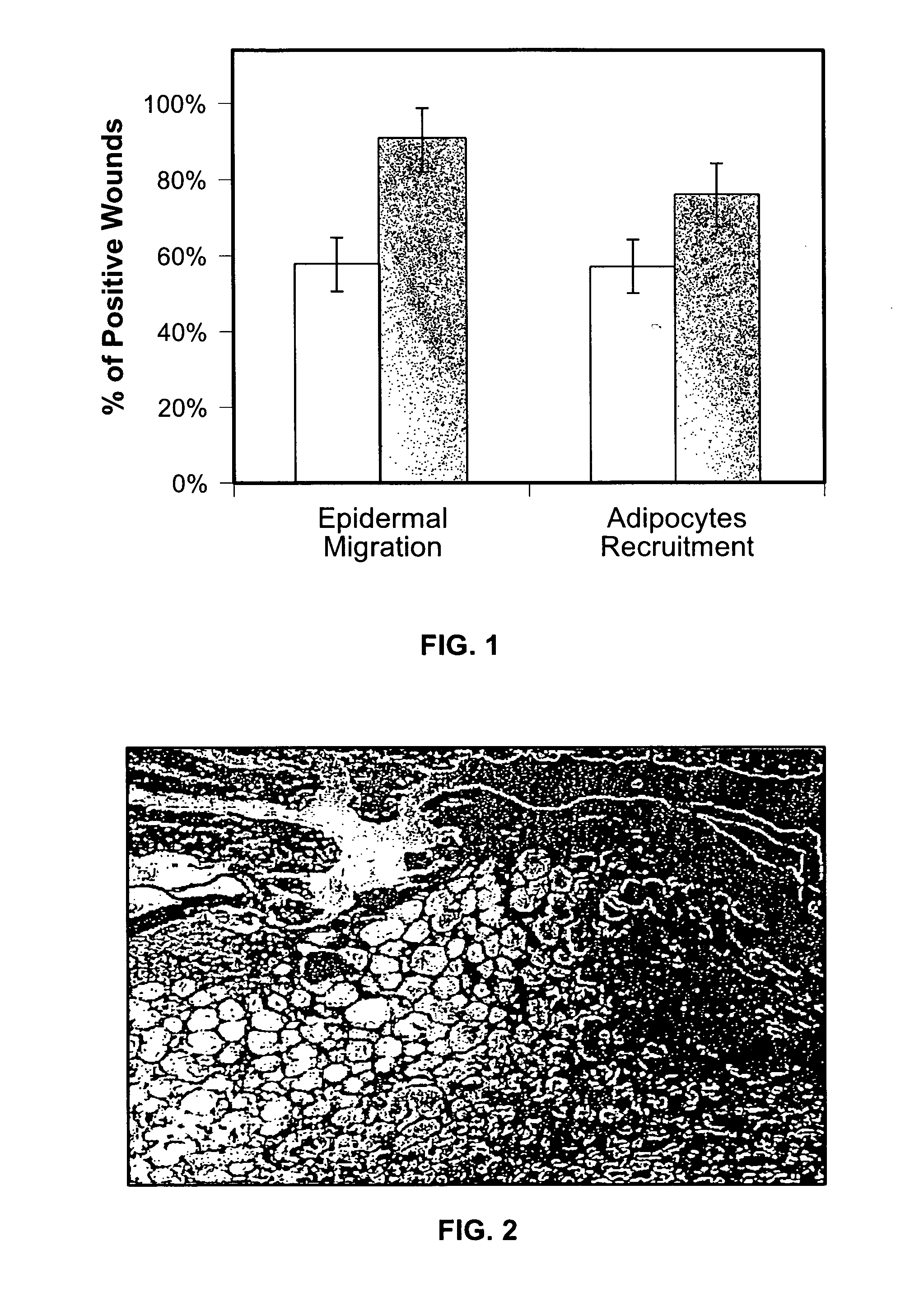Methods for accelerating wound healing by administration of adipokines
a technology of adipokines and wound healing, applied in the direction of drug compositions, dermatological disorders, peptide/protein ingredients, etc., can solve the problems of impaired wound healing, inability to properly function, and inability to properly treat diabetic patients, so as to accelerate the effect of accelerating the healing process of damaged skin or skin wound
- Summary
- Abstract
- Description
- Claims
- Application Information
AI Technical Summary
Benefits of technology
Problems solved by technology
Method used
Image
Examples
example 1
Association of Adipocytes with Migrating Keratinocytes During the Wound Healing Process
[0134]Migrating epidermal cells (keratinocytes) with recruited adipocytes were observed in 7-day-old wound tissue (FIG. 2). As can be seen in FIG. 1, migrating keratinocytes were observed across the wound gap in about 60% of the untreated wounds, and recruited adipocytes were also present in about 60% of the untreated wounds. FIG. 1 also shows that migrating keratinocytes and recruited adipocytes were observed in about 90% and 80% of insulin-treated wounds, respectively.
[0135]These results reveal that migration of keratinocytes to the wound gap area is closely associated with recruitment of adipocytes during an early stage of the wound healing process. The results thus indicate that migration of adipocytes to the wound area is involved in the wound healing process.
example 2
The Effect of PPARγ Modulators on Keratinocytes Migration and Wound Contraction
[0136]The effect of inhibiting or enhancing the activity of peroxisome proliferators-activated receptor gamma (PPARγ) on keratinocytes migration was evaluated utilizing the in vitro migration assay. Thus, primary keratinocytes were isolated and plated on 5 ml non-coated dishes until confluence in low Ca2+ medium, and an artificial crossover scratch was formed in each dish with a 200 μm tip. Cells were either non-treated (control) or treated daily with PPARγ modulators. As can be seen in FIG. 3, the treatment of cultured primary murine keratinocytes with the PPARγ antagonist GW9662 promoted keratinocytes migration. On the other hand, the treatment of cultured keratinocytes with the PPARγ agonist troglitazone inhibited keratinocytes migration (FIG. 8).
[0137]The effect of inhibiting or enhancing the activity of PPARγ using PPARγ antagonist and agonist, respectively, on wound healing was also evaluated in viv...
example 3
The Effect of Adipsin on Keratinocytes Migration and Wound Contraction
[0139]The effect of adipsin (complementing Factor D, which is secreted from adipocytes) on wound healing was evaluated in vivo. Accordingly, full thickness incision wounds were effected on the back of C57BL mice and were treated daily, for 6 days, with PBS buffer (control), or with 1 μM adipsin. The mice were sacrificed 6 days after wounding and the wounds were then analyzed. As illustrated in FIGS. 4-5 and 7, adipsin substantially promoted wound contraction. In addition, adipsin increased epidermal closure from about 15% to about 30%, and increased keratinocytes migration from about 30% to about 65%, as compared with the buffer control (FIG. 6).
[0140]These results demonstrate that an adipokine, such as adipsin, can effectively induce or accelerate wound healing.
PUM
| Property | Measurement | Unit |
|---|---|---|
| diameter×1 | aaaaa | aaaaa |
| time | aaaaa | aaaaa |
| thickness | aaaaa | aaaaa |
Abstract
Description
Claims
Application Information
 Login to View More
Login to View More - R&D
- Intellectual Property
- Life Sciences
- Materials
- Tech Scout
- Unparalleled Data Quality
- Higher Quality Content
- 60% Fewer Hallucinations
Browse by: Latest US Patents, China's latest patents, Technical Efficacy Thesaurus, Application Domain, Technology Topic, Popular Technical Reports.
© 2025 PatSnap. All rights reserved.Legal|Privacy policy|Modern Slavery Act Transparency Statement|Sitemap|About US| Contact US: help@patsnap.com



